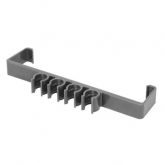My only previous solar install was an AC-coupled (Microinverter) based system, so wiring was pretty simple (240VAC, 2 current-carrying conductors).
I’m now in the thick of planning my first DC-coupled (off-grid) solar install and dealing with DC wiring and multi-conductor wiring for the first time.
I’m planning to use 4-wire 4AWG flexible metal conduit for the 2 home runs, and I’ve understood the presence of 4 conductors in the same conduit means they need to be derated to 80% (so 76A instead of 95A for 4AWG).
After further derating of 1.25 x 1.25 I can have a maximum of 48.64A of PV Isc max for each of these 4AWG home runs (which will translate to 4 parallel panels max per string in my case).
My dumb question is about the 10AWG PV wire running form the panels to the junction box. Is it the case that anytime there are 4 conductors (2 panels) running in parallel for more than 24” (~2/3rds panel width) those 10AWG conductors need to be derated to 80% (32A instead of 40A)?
If so, that would mean a maximum of 20.48A of Iscmax, meaning only a single panel per 10AWG wire for the panel class I am looking at.
And if I use a Y connector to join 2 panels in parallel, I’ll need to step up to 8AWG which will be be able to carry 35.2A of Iscmax (3 panels) if the cable doesn’t follow the same path as other conductors for over 24”, or only 28.16A of Iscmax (2 panels) if the cables follow the same path as other conductors for over 24”?
I’m trying to understand how the 80% derating rule for ‘raceways’ with more than 3 current-carrying conductors applies to the MC4 PV wiring tied to the racking system and whether installers go to the trouble of configuring wiring to avoid more than 24” of overlap for cases where that are using 8AWG to carry a full 35.2A rating of Iscmax.
For example, it’s generally a good idea to tie PV wiring to the inside of the rails of a racking system, but I don’t believe it is a requirement.
If one pair of current-carrying conductors is tied to the inside of the rail and a second pair of current-carrying conductors is tied to the outside (or underneath) of the same rail, does that allow those conductors to be considered ‘not in the same raceway’ and the 20% derating does not need to be applied?
I’m now in the thick of planning my first DC-coupled (off-grid) solar install and dealing with DC wiring and multi-conductor wiring for the first time.
I’m planning to use 4-wire 4AWG flexible metal conduit for the 2 home runs, and I’ve understood the presence of 4 conductors in the same conduit means they need to be derated to 80% (so 76A instead of 95A for 4AWG).
After further derating of 1.25 x 1.25 I can have a maximum of 48.64A of PV Isc max for each of these 4AWG home runs (which will translate to 4 parallel panels max per string in my case).
My dumb question is about the 10AWG PV wire running form the panels to the junction box. Is it the case that anytime there are 4 conductors (2 panels) running in parallel for more than 24” (~2/3rds panel width) those 10AWG conductors need to be derated to 80% (32A instead of 40A)?
If so, that would mean a maximum of 20.48A of Iscmax, meaning only a single panel per 10AWG wire for the panel class I am looking at.
And if I use a Y connector to join 2 panels in parallel, I’ll need to step up to 8AWG which will be be able to carry 35.2A of Iscmax (3 panels) if the cable doesn’t follow the same path as other conductors for over 24”, or only 28.16A of Iscmax (2 panels) if the cables follow the same path as other conductors for over 24”?
I’m trying to understand how the 80% derating rule for ‘raceways’ with more than 3 current-carrying conductors applies to the MC4 PV wiring tied to the racking system and whether installers go to the trouble of configuring wiring to avoid more than 24” of overlap for cases where that are using 8AWG to carry a full 35.2A rating of Iscmax.
For example, it’s generally a good idea to tie PV wiring to the inside of the rails of a racking system, but I don’t believe it is a requirement.
If one pair of current-carrying conductors is tied to the inside of the rail and a second pair of current-carrying conductors is tied to the outside (or underneath) of the same rail, does that allow those conductors to be considered ‘not in the same raceway’ and the 20% derating does not need to be applied?




